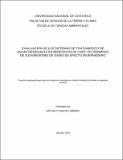| dc.contributor.advisor | Pérez Salazar, Roy | |
| dc.contributor.author | Fuentes Jiménez, Nathaly | |
| dc.date.accessioned | 2020-09-15T01:05:11Z | |
| dc.date.available | 2020-09-15T01:05:11Z | |
| dc.date.issued | 2019 | |
| dc.identifier.uri | http://hdl.handle.net/11056/18152 | |
| dc.description | Proyecto de graduación para optar por el grado de Licenciatura en Gestión Ambiental con énfasis en Ingeniería Sanitaria. | es_ES |
| dc.description.abstract | Este proyecto de graduación evaluó los tipos de sistemas de tratamiento de aguas residuales (STAR) de mayor utilización en los Beneficios de café de Costa Rica, de acuerdo con las emisiones de gases de efecto invernadero (GEI) generadas por estos, además se analizó la viabilidad técnica, económica y ambiental de los diversos sistemas estudiados, como respuesta a la necesidad de encontrar un STAR que genere baja emisión de GEI y que al mismo tiempo mantenga la eficiencia. Esto con el objetivo de reducir el aporte al calentamiento global y evitar la contaminación de los cuerpos de agua.
Lo anterior se realizó mediante un diagnóstico de los STAR y mediciones de flujo de emisión de metano, dióxido de carbono y óxido nitroso, con la técnica de cámara estática de flujos, aplicado a nueve Beneficios ubicados en diferentes zonas geográficas, altitudes, con distinta capacidad de procesamiento y tipo de sistema de tratamiento.
El campo de aspersión sobre pasto estrella mostró ser el sistema de menor emisión de GEI, con un valor de 4 kilogramos de dióxido de carbono equivalente por fanega procesada (kg CO2e/ff), respecto a las lagunas anaerobias con 14 kg CO2e/ff y los reactores anaerobios con 400 kg/CO2e/ff, debido a que en aspersión el proceso se realiza mediante degradación aerobia.
En la viabilidad de implementación del STAR, los campos de aspersión mostraron una ventaja sobre las lagunas y reactores, principalmente por su capacidad de tratamiento, facilidad de manejo de lodos, flexibilidad al cambio de las características del efluente, poca necesidad de personal, bajo costo de construcción, eficiencia en el recurso hídrico y baja emisión de GEI.
Sin embargo, cada tipo de STAR tiene ventajas y desventajas que deben ser analizadas por quien desee implementarlos, para desarrollar el que mejor se ajuste a las necesidades. | es_ES |
| dc.description.abstract | This graduation project evaluated the types of wastewater treatment systems (STAR) most used in the Costa Rican coffee mills, according to the greenhouse gas (GHG) emissions generated by them, and also analyzed the technical, economic and environmental viability of the various systems studied, in response to the need to find a STAR that generates low GHG emissions and at the same time maintains efficiency. This with the aim of reducing the contribution to global warming and avoiding the contamination of bodies of water.
The foregoing was carried out through a diagnosis of the STARs and measurements of methane, carbon dioxide and nitrous oxide emission flow, with the static flow chamber technique, applied to nine mills located in different geographic areas, altitudes, with different capacities. processing and type of treatment system.
The spray field on star grass proved to be the system with the lowest GHG emissions, with a value of 4 kilograms of carbon dioxide equivalent per bushel processed (kg CO2e / ff), compared to anaerobic lagoons with 14 kg CO2e / ff and anaerobic reactors with 400 kg / CO2e / ff, because in aspersion the process is carried out by aerobic degradation.
In the viability of STAR implementation, the spray fields showed an advantage over the lagoons and reactors, mainly due to their treatment capacity, ease of handling sludge, flexibility to change the characteristics of the effluent, little need for personnel, low cost. construction, water resource efficiency and low GHG emissions.
However, each type of STAR has advantages and disadvantages that must be analyzed by whoever wants to implement them, to develop the one that best suits the needs. | es_ES |
| dc.description.sponsorship | Universidad Nacional, Costa Rica | es_ES |
| dc.language.iso | spa | es_ES |
| dc.publisher | Universidad Nacional, Costa Rica | es_ES |
| dc.rights | Acceso abierto | es_ES |
| dc.rights | Attribution-NonCommercial-NoDerivatives 4.0 Internacional | * |
| dc.rights.uri | http://creativecommons.org/licenses/by-nc-nd/4.0/ | * |
| dc.subject | EFLUENTES | es_ES |
| dc.subject | COSTA RICA | es_ES |
| dc.subject | GASES | es_ES |
| dc.subject | CONTAMINACIÓN | es_ES |
| dc.subject | PROTECCIÓN AMBIENTAL | es_ES |
| dc.subject | EFFLUENTS | es_ES |
| dc.subject | GASES | es_ES |
| dc.subject | CONTAMINATION | es_ES |
| dc.subject | ENVIRONMENTAL PROTECTION | es_ES |
| dc.title | Evaluación de los sistemas de tratamiento de aguas residuales en beneficios de café en términos de sus emisiones de gases de efecto invernadero | es_ES |
| dc.type | http://purl.org/coar/resource_type/c_7a1f | es_ES |
| una.tesis.numero | TESIS 10574 | es_ES |
| dc.description.procedence | Escuela de Ciencias Ambientales | es_ES |


